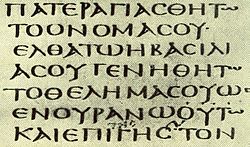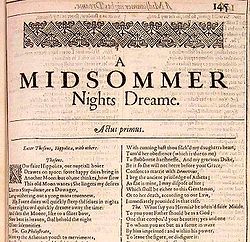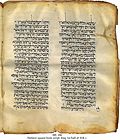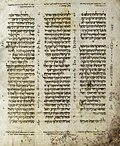Textual criticism
Textual criticism is the study of different copies of books or manuscripts. The purpose is to find the original, and see what changes were made to the later versions.
Textual criticism started with the study of the Bible, but now these techniques are used to study many texts.
Basic notions and objectives
The basic problem, as described by Paul Maas, is as follows:
- "We have no autograph manuscripts of the Greek and Roman classical writers and no copies which have been [compared] with the originals; the manuscripts we possess derive from the originals through an unknown number of intermediate copies, and are consequentially of questionable trustworthiness. The business of textual criticism is to produce a text as close as possible to the original". [1]p1
The lack of autograph manuscripts applies to many cultures other than Greek and Roman. In such a situation, a key objective becomes the identification of the first exemplar before any split in the tradition. That exemplar is known as the archetype. "If we succeed in establishing the text of [the archetype], the reconstruction of the original is considerably advanced".[1]pp22–23
The textual critic's ultimate objective is the production of a "critical edition". This contains a text most closely approximating the original, which is accompanied by a critical apparatus that presents:
- the evidence that the editor considered (names of manuscripts),
- the editor's analysis of that evidence and
- a record of rejected variants (often in order of preference).[1]pp22–23
Textual Criticism Media
Carmina Cantabrigiensia, Manuscript C, folio 436v, 11th century
Folio from Papyrus 46, containing 2 Corinthians 11:33–12:9
Luke 11:2 in Codex Sinaiticus
Scheme of descent of the manuscripts of Pseudo-Apuleius Herbarius by Henry E. Sigerist (1927)
Canterbury Tales, Woodcut 1484
A page from Codex Vaticanus Graecus 1209 shows a medieval scribe (the marginal note between columns one and two) criticizing a predecessor for changing the text: "Fool and knave, leave the old reading, don't change it!"[2]
11th-century manuscript of the Hebrew Bible with Targum
A page from the Aleppo Codex, Deuteronomy.
Sana'a manuscripts of the Quran. Andrew Rippin has stated that the discovery of Sana'a manuscript is significant, and its variant readings suggest that the early Quranic text was less stable than previously claimed.
Related pages
References
- ↑ 1.0 1.1 1.2 Maas P. 1958. Textual criticism. Oxford.
- ↑ Ehrman 2005, pp. 44, 56.









